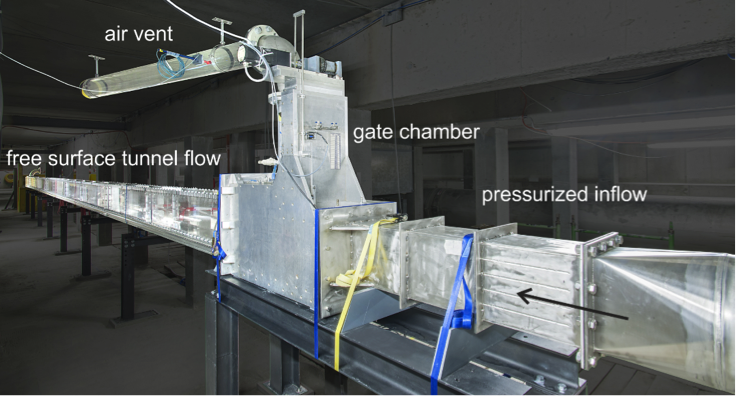The hydraulics of low-level outlet structures of large dams
Bottom outlets are a key safety device of dams with the purpose of discharging water in a timely and quantitatively defined volume without causing damage. The high-velocity flow in bottom outlets requires sufficient aeration to avoid cavitation damage. This project aims at developing design guidelines to ensure the safe and reliable operation of bottom outlets.
Bottom outlets are used to control the water level during the first impoundment, for rapid drawdown of reservoirs in emergency situations such as extreme floods or after structural damage to the dam, and for the flushing of sediments. The operation of bottom outlets is expected to increase in the near future due to (1) increasing problems with reservoir sedimentation and (2) dam heightening, which is an adequate measure to increase (winter) energy production in accordance with the Swiss energy strategy 2050.
The high-speed flow in bottom outlets results in considerable air entrainment and air transport causing negative pressures along the outlet tunnel. Problems regarding cavitation damage and gate vibration are the consequence. These problems can be mitigated by sufficient aeration of the gate chamber through an air vent. Up to date, there are no general design guidelines to predict the air demand and the air-water two-phase flow characteristics of bottom outlets.
A large-scale hydraulic model (Fig.1) at the Laboratory of Hydraulics, Hydrology and Glaciology (VAW, ETH Zurich) is used to investigate the effect of relevant parameters, i.e. energy head, gate opening, tunnel and air vent geometry on the air demand of bottom outlets. The project is financed by the Swiss National Science Foundation (SNF grant Nr. 163415) and supported by the Swiss Competence Center for Energy research - Supply o Electricity (SCCER-SoE).

The ESC member involved in this project is Prof. Robert Boes, head of the Laboratory of Hydraulics, Hydrology and Glaciology ,which conducts research and teaching in the fields of hydraulic engineering, river engineering and glaciology. Studies in the areas of hydraulic structures for energy production, irrigation and water supply, protection against natural hazards (flood protection, debris flow, glacial risks, impulse waves) and renaturation of watercourses are complemented by research and services in the areas of dynamics of polar ice streams and glaciers, as well as processes relating to glaciers and climate change.
